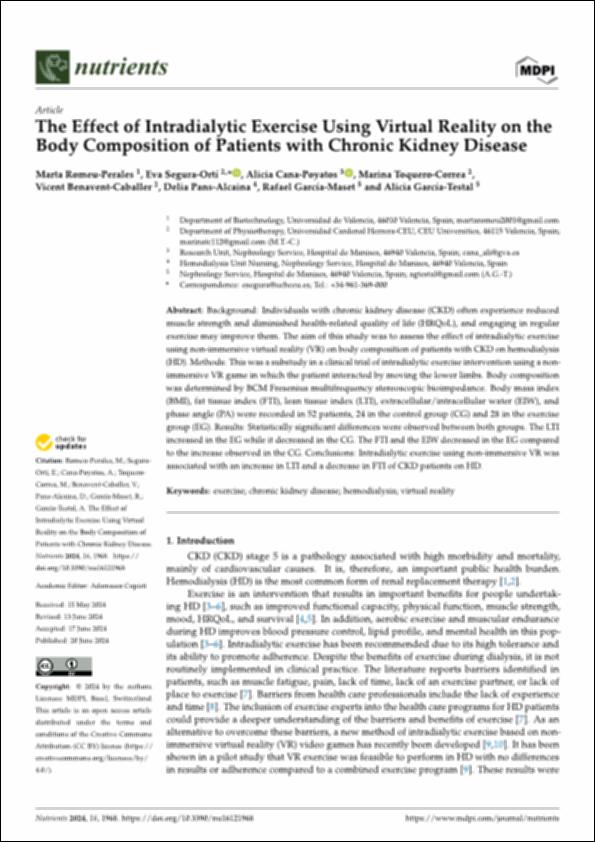Por favor, use este identificador para citar o enlazar este ítem:
http://hdl.handle.net/10637/16038The effect of intradialytic exercise using virtual reality on the body composition of patients with chronic kidney disease
| Título : | The effect of intradialytic exercise using virtual reality on the body composition of patients with chronic kidney disease |
| Autor : | Romeu Perales, Marta Segura Ortí, Eva Cana Poyatos, Alicia Toquero Correa, Marina Benavent Caballer, Vicente Pans Alcaina, Delia García Maset, Rafael García Testal, Alicia |
| Materias: | Realidad virtual; Virtual reality; Ejercicio físico; Exercise; Hemodiálisis; Hemodialysis; Insuficiencia renal crónica; Chronic renal failure |
| Editorial : | MDPI |
| Citación : | Romeu-Perales, M., Segura-Ortí, E., Cana-Poyatos, A., Toquero-Correa, M., Benavent-Caballer, V., Pans-Alcaina, D., García-Maset, R. & García-Testal, A. (2024). The effect of intradialytic exercise using virtual reality on the body composition of patients with chronic kidney disease. Nutrients, vol. 16, i. 12 (20 jun.), art. 1968. DOI: https://doi.org/10.3390/nu16121968 |
| Resumen : | Background: Individuals with chronic kidney disease (CKD) often experience reduced muscle strength and diminished health-related quality of life (HRQoL), and engaging in regular exercise may improve them. The aim of this study was to assess the effect of intradialytic exercise using non-immersive virtual reality (VR) on body composition of patients with CKD on hemodialysis (HD). Methods: This was a substudy in a clinical trial of intradialytic exercise intervention using a non-immersive VR game in which the patient interacted by moving the lower limbs. Body composition was determined by BCM Fresenius multifrequency stereoscopic bioimpedance. Body mass index (BMI), fat tissue index (FTI), lean tissue index (LTI), extracellular/intracellular water (EIW), and phase angle (PA) were recorded in 52 patients, 24 in the control group (CG) and 28 in the exercise group (EG). Results: Statistically significant differences were observed between both groups. The LTI increased in the EG while it decreased in the CG. The FTI and the EIW decreased in the EG compared to the increase observed in the CG. Conclusions: Intradialytic exercise using non-immersive VR was associated with an increase in LTI and a decrease in FTI of CKD patients on HD. |
| Descripción : | Este artículo pertenece a la sección "Nutrition and Metabolism". |
| URI : | http://hdl.handle.net/10637/16038 |
| Derechos: | http://creativecommons.org/licenses/by/4.0/deed.es Open Access |
| ISSN : | 2072-6643 (Electrónico) |
| Fecha de publicación : | 20-jun-2024 |
| Centro : | Universidad Cardenal Herrera-CEU |
| Aparece en las colecciones: | Dpto. Enfermería y Fisioterapia |
Los ítems de DSpace están protegidos por copyright, con todos los derechos reservados, a menos que se indique lo contrario.


